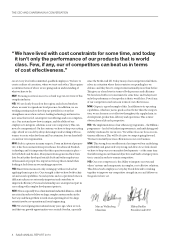Saab 2010 Annual Report Download - page 21
Download and view the complete annual report
Please find page 21 of the 2010 Saab annual report below. You can navigate through the pages in the report by either clicking on the pages listed below, or by using the keyword search tool below to find specific information within the annual report.
MORE EFFICIENT
OPERATIONS
To be more competitive, we have to continuously develop,
manage and realise the most effective ways of working.
Increasing the degree of standardisation is one way of
raising efficiency.
Higher eciency to us primarily means working in a structured
manner, so that the costs of reaching our goals in various areas are as
low as possible. Initially, have to ensure that standardised and har-
monised work methods are in place and to prioritise among our
activities. e next step is to measure the results of our work and
make the progress we have made visible in the organisation. For this
to succeed, we have to promote a culture that puts our common
good ahead of what might be best locally.
An efficient Saab
Saab has been working for some time to be a more integrated com-
pany in terms of goals, priorities and processes. e reorganisation
into ve distinct business areas at the start of was an important
step. It makes it easier for us to capitalise on functional synergies and
nancial resources, develop new, standardised processes and
develop a more focused product portfolio. In addition to the reor-
ganisation, we have established a number of functions to support
our collective eorts and internal eciency, including centres of
excellence in research and development. For more information, see
next page.
At the end of , we completed a SEK . billion cost-cutting
programme on schedule. is work has now become an integral part
of our day-to-day operations, where we continue to reduce our costs
through improvements.
We are also reassessing our cost structure to better adapt it to our
long-term strategy. is includes structural changes beyond those to
improve eciencies in internal processes. For example, we have
taken measures to reduce our administrative costs.
Five priorities
In our eciency improvements, we focus on ve strategic areas to
become a more cost-eective organisation. ey can be summarised
as follows:
• Standardise and harmonise operations in order to drive cost e-
ciencies through functional synergies.
• Optimise R&D eciency through standardised product manage-
ment and development processes.
• Focus on contract quality, project implementation and risk man-
agement to improve project results and forecasting abilities.
• Increase exibility in our cost structure to adapt to variations in
volume.
• Ensure we can maintain a stable cash ow to facilitate invest-
ments for growth in acquisitions, R&D and marketing.
In each of these areas, we are working on a number of activities. In
terms of standardisation and harmonisation, this includes every-
thing from maintaining ecient enterprise systems with the best
industry standards and co-ordinating sourcing (higher volumes and
fewer suppliers) to optimising our assets.
To improve R&D eciency, we are trying to adopt a uniform life-
cycle process for our products and to increase modularity. We also
need to have clearly dened criteria in order to prioritise R&D
investments. Learn more about our research and development on
pages –.
With the help of a well-dened business and management model,
as well as a uniform project model, we can improve our earnings
potential through contract formulations and eective project imple-
mentation in all our business areas.
We are increasing the exibility of our cost structure by continu-
ously evaluating the size of the organisation’s workforce, buying
expertise that falls outside our core competencies and conduct cost
benchmarking.
We also have to maintain a stable cash ow to facilitate growth-
driving investments. We achieve this by focusing on payment plans
in tenders/contracts and resource-ecient project implementation,
while reducing capital tied up in account receivables and inventories.
Saab’s four strategic priorities
PORTFOLIO
PEOPLE
PROFITABLE
GROWTH
PERFORMANCE
18 SAAB ANNUAL REPORT 2010
SAAB’S STRATEGIC PRIORITIES > EFFICIENT OPERATIONS
























